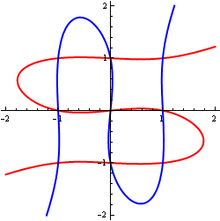
In mathematics, Cramer's paradox or the Cramer–Euler paradox[1] is the statement that the number of points of intersection of two higher-order curves in the plane can be greater than the number of arbitrary points that are usually needed to define one such curve. It is named after the Genevan mathematician Gabriel Cramer.
This phenomenon appears paradoxical because the points of intersection fail to uniquely define any curve (they belong to at least two different curves) despite their large number. It is the result of a naive understanding or a misapplication of two theorems:
- Bézout's theorem states that the number of points of intersection of two algebraic curves is equal to the product of their degrees, provided that certain necessary conditions are met. In particular, two curves of degree generally have points of intersection.
- Cramer's theorem states that a curve of degree is determined by points, again assuming that certain conditions hold.
For all , , so it would naively appear that for degree three or higher, the intersection of two curves would have enough points to define either of the curves uniquely. However, because these points belong to both curves, they do not define a unique curve of this degree. The resolution of the paradox is that the bound on the number of points needed to define a curve only applies to points in general position. In certain degenerate cases, points are not enough to determine a curve uniquely.
- ^ Weisstein, Eric W. "Cramér-Euler Paradox." From MathWorld--A Wolfram Web Resource. http://mathworld.wolfram.com/Cramer-EulerParadox.html






